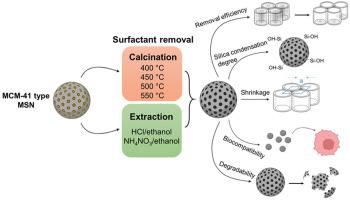当前位置:
X-MOL 学术
›
Micropor. Mesopor. Mater.
›
论文详情
Our official English website, www.x-mol.net, welcomes your feedback! (Note: you will need to create a separate account there.)
Systematic study of the implications of calcination and solvent extraction of the surfactant in MCM-41-type mesoporous silica nanoparticles
Microporous and Mesoporous Materials ( IF 5.2 ) Pub Date : 2024-04-07 , DOI: 10.1016/j.micromeso.2024.113119 Vicente Candela-Noguera , Pedro Amorós , Elena Aznar , María Dolores Marcos , Ramón Martínez-Máñez
Microporous and Mesoporous Materials ( IF 5.2 ) Pub Date : 2024-04-07 , DOI: 10.1016/j.micromeso.2024.113119 Vicente Candela-Noguera , Pedro Amorós , Elena Aznar , María Dolores Marcos , Ramón Martínez-Máñez

|
Mesoporous silica nanoparticles (MSN) have been growing in recent years in a broad range of applications, such as nanomedicine, catalysis, and gas storage. For the preparation of MSN, especially in nanomedicine applications, the extraction of the surfactant template, generally 1-hexadecyltrimethylammonium bromide (CTAB), is required. Several methods to remove the surfactant from MNS have been reported in the literature, such as calcination, solvent extraction, and dialysis. Depending on the method employed, the materials obtained have different properties; however, a systematic study that compares the use of different surfactant extraction methods and their implications in the final characteristics of the MSN has not been reported. Hence, the aim of this work is to study the effect of surfactant removal on MSN by calcination at different temperatures (400 °C, 450 °C, 500 °C and 550 °C) or by extraction with HCl/ethanol or NHNO/ethanol. The final materials are fully characterised by different techniques. The study performed shows the removal efficiency when the different methods are used, and their effect on silica condensation degree, mesoporosity, cytotoxicity, and degradation rate. The results allow for obtaining a deeper knowledge of the surfactant removal processes.
中文翻译:

系统研究 MCM-41 型介孔二氧化硅纳米颗粒中表面活性剂的煅烧和溶剂萃取的影响
近年来,介孔二氧化硅纳米颗粒(MSN)在纳米医学、催化和气体储存等广泛应用中不断发展。对于MSN的制备,特别是在纳米医学应用中,需要提取表面活性剂模板,通常是1-十六烷基三甲基溴化铵(CTAB)。文献报道了几种从MNS中去除表面活性剂的方法,例如煅烧、溶剂萃取和透析。根据所采用的方法,获得的材料具有不同的性能;然而,尚未报道比较不同表面活性剂提取方法的使用及其对 MSN 最终特性的影响的系统研究。因此,本工作的目的是研究通过在不同温度(400℃、450℃、500℃和550℃)下煅烧或用HCl/乙醇或NHNO3/乙醇萃取去除表面活性剂对MSN的影响。最终材料通过不同的技术得到充分表征。进行的研究显示了使用不同方法时的去除效率,以及它们对二氧化硅凝聚度、中孔率、细胞毒性和降解率的影响。这些结果使我们能够更深入地了解表面活性剂的去除过程。
更新日期:2024-04-07
中文翻译:

系统研究 MCM-41 型介孔二氧化硅纳米颗粒中表面活性剂的煅烧和溶剂萃取的影响
近年来,介孔二氧化硅纳米颗粒(MSN)在纳米医学、催化和气体储存等广泛应用中不断发展。对于MSN的制备,特别是在纳米医学应用中,需要提取表面活性剂模板,通常是1-十六烷基三甲基溴化铵(CTAB)。文献报道了几种从MNS中去除表面活性剂的方法,例如煅烧、溶剂萃取和透析。根据所采用的方法,获得的材料具有不同的性能;然而,尚未报道比较不同表面活性剂提取方法的使用及其对 MSN 最终特性的影响的系统研究。因此,本工作的目的是研究通过在不同温度(400℃、450℃、500℃和550℃)下煅烧或用HCl/乙醇或NHNO3/乙醇萃取去除表面活性剂对MSN的影响。最终材料通过不同的技术得到充分表征。进行的研究显示了使用不同方法时的去除效率,以及它们对二氧化硅凝聚度、中孔率、细胞毒性和降解率的影响。这些结果使我们能够更深入地了解表面活性剂的去除过程。






























 京公网安备 11010802027423号
京公网安备 11010802027423号